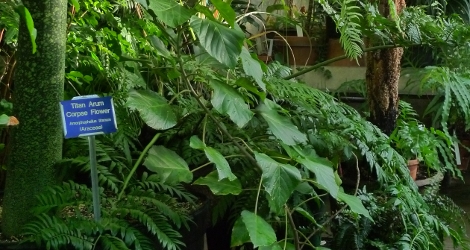Accession Data:
Andrographis paniculata (Burm. f.) Wall. ex Nees
- Common Name: King of Bitters, Kalmegh, Chuan-xin-lian
- Family: Acanthaceae Juss.
- Uses: Many uses of the plant include for stomach aches, inflammation, pyrexia, and intermittent fevers. The entire plant has been used in a mixture for poisonous stings of some insects, to treat dyspepsia, influenza, dysentery, malaria and respiratory infection and even snake-bites. The leaf extract is a traditional remedy for the treatment of infectious diseases, fever-causing diseases, colic pain, loss of appetite, irregular stools and diarrhea 2.
The aerial part of the plant can be used to treat the common cold, hypertension, diabetes, cancer, malaria and snakebite, urinary tract infection. In different regions of India, Andrographis paniculata is used to treat malaria, intestinal worm infestation, jaundice, eczema, gonorrhea and other ailments.
- IMPORTANT NOTE: Plant Uses are for informational purposes only. EEB Greenhouses assume no responsibility for adverse effects from the use of any plants referred to on this site. Always seek advice from a professional before using any plant medicinally.
Accession Data:
- Accession # 201200002
- Source: Horizon Herbs
- Accession Date: 01-24-2012
- Bench: 0 - unassigned location
- Currently: deceased
- Qty: 0 confirmed on 09-07-2022
Classification:
- Division: Magnoliophyta
- Class: Magnoliopsida
- SubClass: euasterid I
- Order: Lamiales
- SubOrder:
- Family: Acanthaceae
- SubFamily: Acanthoideae
- Tribe: Andrographideae
- SubTribe:
Flowering Data:
This accession has been observed in bloom on:| Year | Jan | Feb | Mar | Apr | May | Jun | Jul | Aug | Sep | Oct | Nov | Dec | ||||||||||||||||||||||||||||||||||||||||
|---|---|---|---|---|---|---|---|---|---|---|---|---|---|---|---|---|---|---|---|---|---|---|---|---|---|---|---|---|---|---|---|---|---|---|---|---|---|---|---|---|---|---|---|---|---|---|---|---|---|---|---|---|
| 2022 | ||||||||||||||||||||||||||||||||||||||||||||||||||||
| 2021 | ||||||||||||||||||||||||||||||||||||||||||||||||||||
| 2020 | ||||||||||||||||||||||||||||||||||||||||||||||||||||
| 2019 | ||||||||||||||||||||||||||||||||||||||||||||||||||||
| 2018 | ||||||||||||||||||||||||||||||||||||||||||||||||||||
| 2017 | ||||||||||||||||||||||||||||||||||||||||||||||||||||
| 2016 | ||||||||||||||||||||||||||||||||||||||||||||||||||||
| 2015 | ||||||||||||||||||||||||||||||||||||||||||||||||||||
| 2014 | ||||||||||||||||||||||||||||||||||||||||||||||||||||
References (internal):
- Medicinal Plants - Ayurveda Medicine
- Medicinal Plants - Integumentary System
- Medicinal Plants - Respiratory System
- Medicinal Plants - Immune System
- Medicinal Plants - Digestive System
- Medicinal Plants - Circulatory System
References (external):
- The Plant List (2013). Version 1.1. Last accessed on Wednesday, September 07, 2016.]
- A. Okhuarobo, J. Ehizogie Falodun, O. Erharuyi, V. Imieje, A. Falodun, P. Langer Harnessing the medicinal properties of Andrographis paniculata for diseases and beyond: a review of its phytochemistry and pharmacology Asian Pac J Trop Dis. 2014 Jun; 4(3): 213–222. Last accessed on Thursday, March 29, 2018.
data regenerated on Wed, 07 Sep 2022 14:42:06 -0400 [bcm v4.0]
Images:

Additional images for this accession:
Click on thumbnails to enlargeCurrent Accessions in the Acanthaceae
Subfamily Acanthoideae
Tribe Acantheae
Subfamily Acanthoideae
Tribe Barlerieae
Subfamily Acanthoideae
Tribe Justicieae
- Dicliptera sericea
- Ecbolium viride


- Fittonia albivenis

- Hypoestes phyllostachya

- Justicia brandegeeana "Yellow Queen"

- Justicia brandegeeana



- Justicia carnea



- Justicia cydoniifolia



- Odontonema callistachyum

- Pachystachys lutea



- Pseuderanthemum laxiflorum

- Ruttya fruticosa



- Streblacanthus amoenus


Subfamily Acanthoideae
Tribe Ruellieae
- Brillantaisia ulugurica


- Eranthemum pulchellum


- Hemigraphis alternata
- Ruellia affinis


- Ruellia makoyana

- Sanchezia speciosa

- Strobilanthes dyeriana


Subfamily Acanthoideae
Tribe Whitfieldieae
Subfamily Thunbergioideae
W/C = Wild Collected = indicates flowering in past 14 days
= indicates flowering in past 14 days
 = images available for this accession
= images available for this accession
 = map available for this accession
= map available for this accession
 = accession added within past 90 days
= accession added within past 90 days
